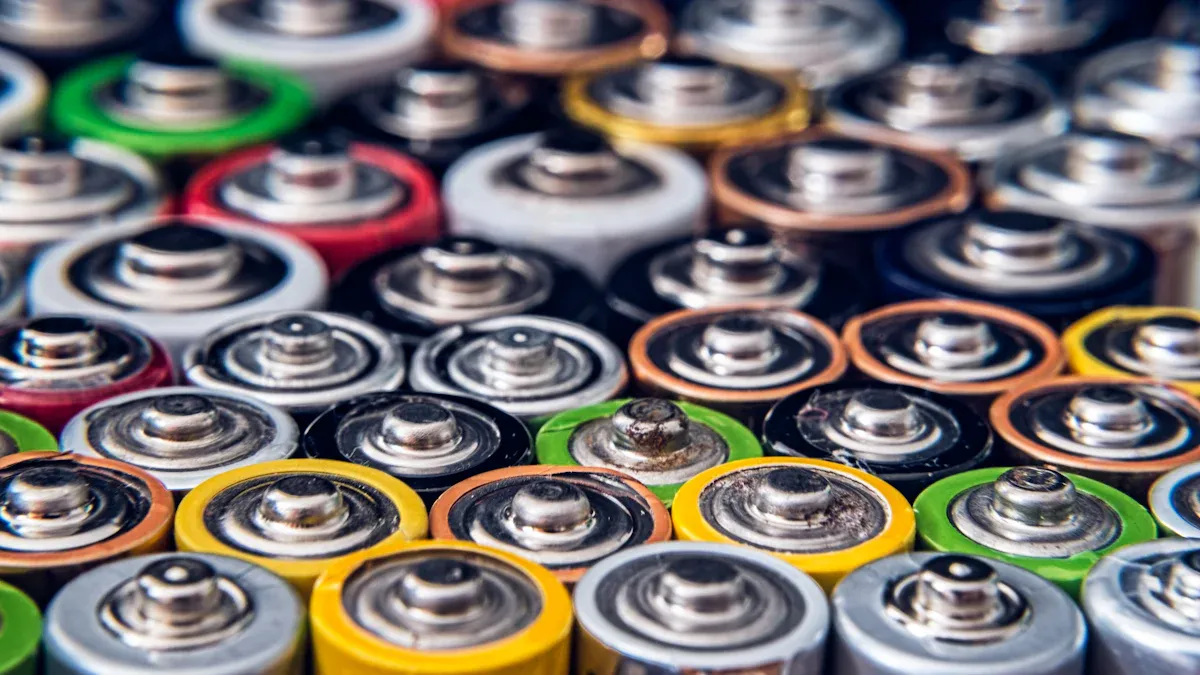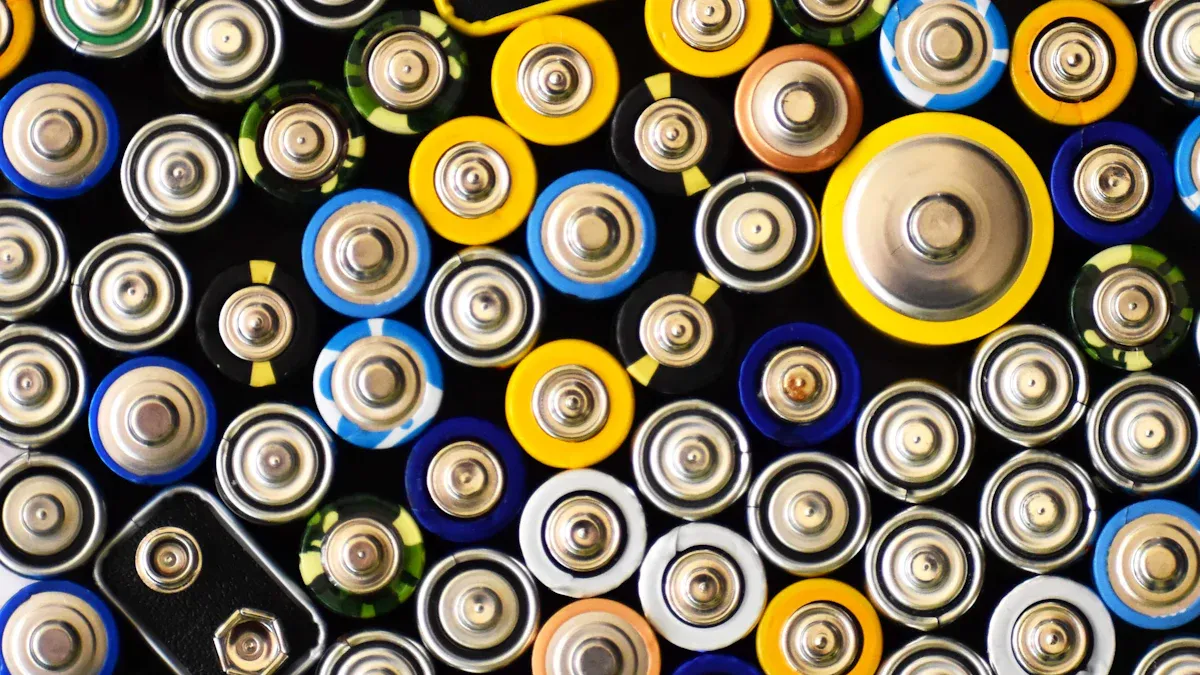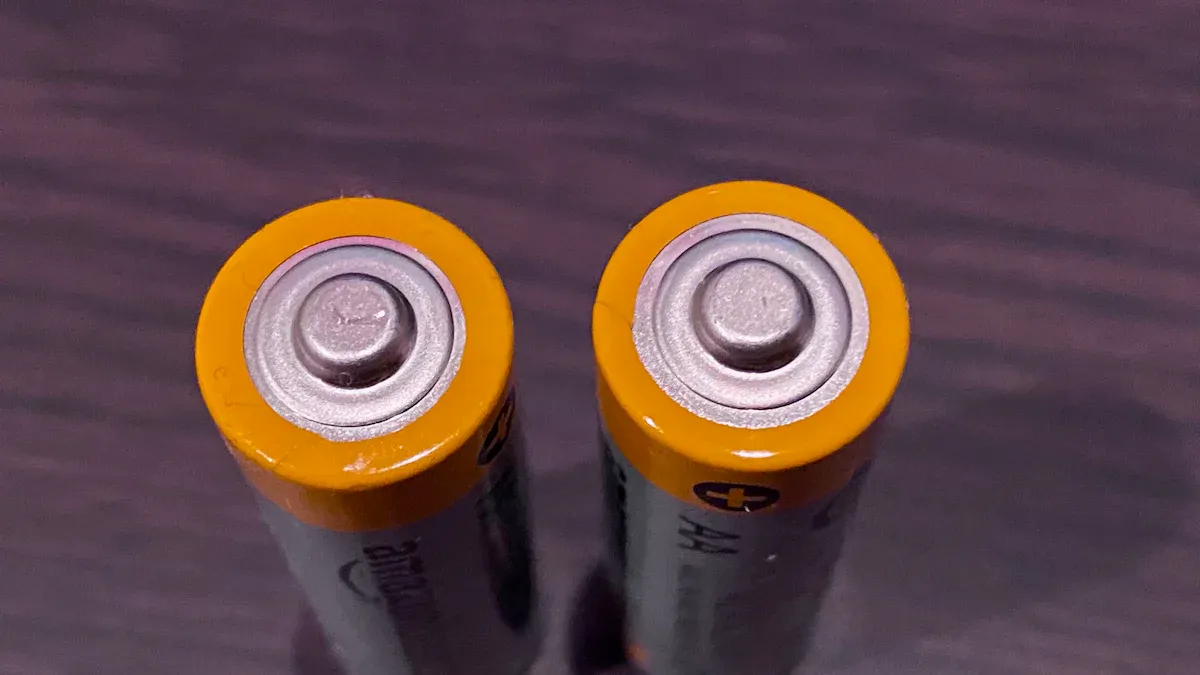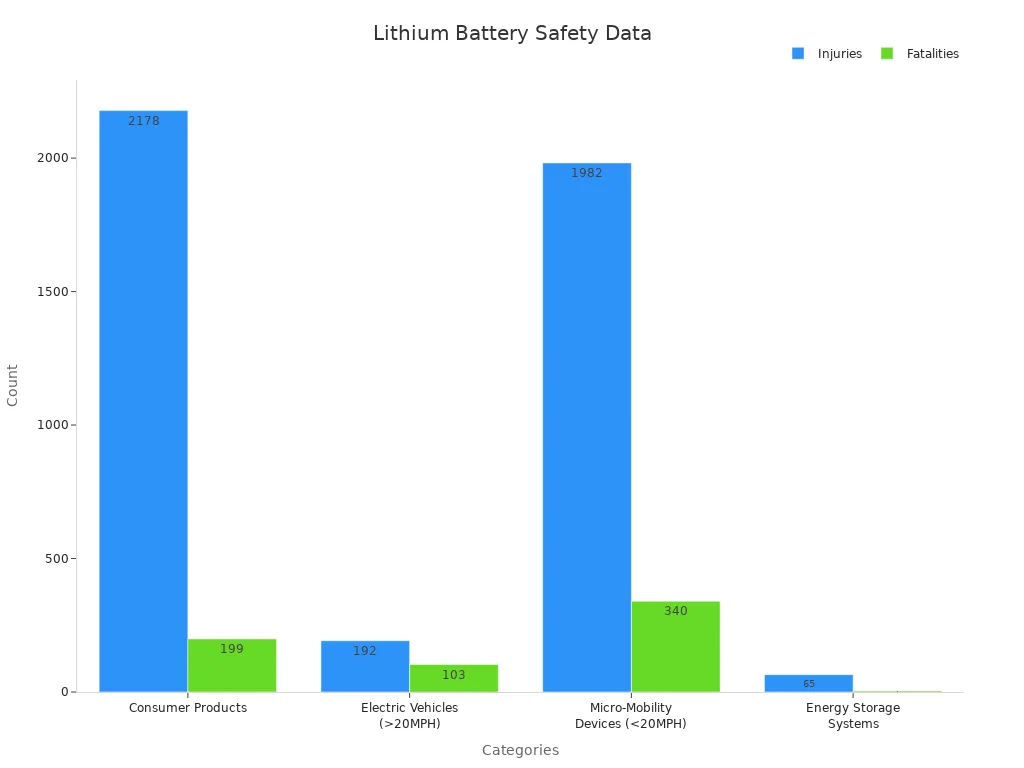
Choosing between NiMH or lithium rechargeable batteries depends on the specific requirements of the user. Each type offers distinct advantages in performance and usability.
- NiMH batteries deliver stable performance even in cold conditions, making them reliable for consistent power delivery.
- Lithium rechargeable batteries excel in cold weather due to advanced chemistry and internal heating, ensuring minimal performance loss.
- Lithium batteries provide higher energy density and a longer lifespan, making them ideal for modern electronics.
- Charging times for lithium batteries are faster compared to NiMH batteries, offering greater convenience.
Understanding these differences helps users make informed decisions based on their needs.
Key Takeaways
- NiMH batteries cost less and work well for home gadgets. They are good for daily use.
- Lithium batteries charge quickly and last longer. They are best for powerful devices like phones and electric cars.
- Knowing energy storage and battery life helps pick the right one.
- Both types need care to last longer. Keep them away from heat and don’t overcharge.
- Recycling NiMH and lithium batteries helps the planet and supports eco-friendly habits.
Overview of NiMH or lithium rechargeable batteries
What are NiMH batteries?
Nickel-metal hydride (NiMH) batteries are rechargeable batteries that use nickel hydroxide as the positive electrode and a hydrogen-absorbing alloy as the negative electrode. These batteries rely on aqueous electrolytes, which enhance safety and affordability. NiMH batteries are widely used in consumer electronics, electric vehicles, and renewable energy storage systems due to their robustness and ability to retain charge over time.
Key technical specifications of NiMH batteries include:
- Specific energy: 0.22–0.43 MJ/kg (60–120 W·h/kg)
- Energy density: 140–300 W·h/L
- Cycle durability: 180–2000 cycles
- Nominal cell voltage: 1.2 V
The electric vehicle industry has embraced NiMH batteries for their high-power capabilities. Their charge retention and longevity make them suitable for renewable energy applications.
What are lithium rechargeable batteries?
Lithium rechargeable batteries are advanced energy storage devices that use lithium salts in organic solvents as electrolytes. These batteries feature high energy density and specific energy, making them ideal for modern electronics and weight-sensitive applications like electric vehicles. Lithium batteries charge faster and last longer compared to NiMH batteries.
Key performance metrics include:
| Metric | Description | Importance |
|---|---|---|
| Energy Density | The amount of energy stored per unit volume. | Longer usage times in devices. |
| Specific Energy | Energy stored per unit mass. | Crucial for lightweight applications. |
| Charge Rate | Speed at which a battery can be charged. | Enhances convenience and reduces downtime. |
| Swell Rate | Expansion of anode material during charging. | Ensures safety and longevity. |
| Impedance | Resistance within the battery when current flows. | Indicates better performance and efficiency. |
Lithium batteries dominate the market for portable electronics and electric vehicles due to their superior performance metrics.
Key differences in chemistry and design
NiMH and lithium rechargeable batteries differ significantly in their chemical composition and design. NiMH batteries use nickel hydroxide as the positive electrode and aqueous electrolytes, which limit their voltage to around 2V. Lithium batteries, on the other hand, employ lithium salts in organic solvents and non-aqueous electrolytes, enabling higher voltages.
NiMH batteries benefit from additives in electrode materials, which improve charge efficiency and reduce mechanical strain. Lithium batteries achieve higher energy density and faster charge rates, making them suitable for high-performance applications.
These differences highlight the unique advantages of each battery type, allowing users to choose based on their specific needs.
Performance of NiMH or lithium rechargeable batteries

Energy density and voltage
Energy density and voltage are critical factors when comparing NiMH or lithium rechargeable batteries. Energy density refers to the amount of energy stored per unit weight or volume, while voltage determines the power output of the battery.
| Parameter | NiMH | Lithium |
|---|---|---|
| Energy Density (Wh/kg) | 60-120 | 150-250 |
| Volumetric Energy Density (Wh/L) | 140-300 | 250-650 |
| Nominal Voltage (V) | 1.2 | 3.7 |
Lithium batteries outperform NiMH batteries in both energy density and voltage. Their higher energy density allows devices to run longer on a single charge, while their nominal voltage of 3.7V supports high-performance applications. NiMH batteries, with a nominal voltage of 1.2V, are better suited for devices requiring steady, moderate power. This makes them ideal for household electronics like remote controls and flashlights.
Cycle life and durability
Cycle life measures how many times a battery can be charged and discharged before its capacity significantly decreases. Durability refers to the battery’s ability to maintain performance under various conditions.
NiMH batteries typically last between 180 and 2,000 cycles, depending on usage and maintenance. They perform well under consistent, moderate loads but may degrade faster when exposed to high discharge rates. Lithium batteries, on the other hand, offer a cycle life of 300 to 1,500 cycles. Their durability is enhanced by advanced chemistry, which minimizes wear and tear during charging and discharging.
Both battery types experience reduced performance under heavy loads. However, lithium batteries generally retain their capacity better over time, making them a preferred choice for devices requiring frequent recharging, such as smartphones and laptops.
Tip: To extend the cycle life of either battery type, avoid exposing them to extreme temperatures and overcharging.
Charging speed and efficiency
Charging speed and efficiency are essential for users who prioritize convenience. Lithium batteries charge faster than NiMH batteries due to their ability to handle higher current inputs. This reduces downtime, especially for devices like electric vehicles and power tools.
- NiMH batteries perform optimally with DC and analog loads. Digital loads, however, can shorten their cycle life.
- Lithium batteries exhibit similar behavior, with their cycle life influenced by varying discharge levels.
- Both battery types show reduced performance under higher load conditions.
Lithium batteries also boast higher charging efficiency, meaning less energy is lost as heat during the charging process. NiMH batteries, while slower to charge, remain a reliable option for applications where speed is less critical.
Note: Always use chargers designed for the specific battery type to ensure safety and maximize efficiency.
Cost of NiMH or lithium rechargeable batteries
Upfront costs
The initial cost of NiMH or lithium rechargeable batteries varies significantly due to differences in their chemistry and design. NiMH batteries are generally more affordable upfront. Their simpler manufacturing process and lower material costs make them accessible for budget-conscious consumers. Lithium batteries, however, require advanced materials and technology, which increases their price.
For example, NiMH battery packs often cost less than 50% of lithium battery packs. This affordability makes NiMH batteries a popular choice for household electronics and low-cost renewable energy systems. Lithium batteries, while more expensive, offer higher energy density and longer lifespans, which justify their higher price for high-performance applications like electric vehicles and portable electronics.
Tip: Consumers should weigh upfront costs against long-term benefits when choosing between these two battery types.
Long-term value and maintenance
The long-term value of NiMH or lithium rechargeable batteries depends on their durability, maintenance needs, and performance over time. NiMH batteries require specific maintenance due to their self-discharge and memory effect. These issues can reduce their efficiency if not properly managed. Lithium batteries, on the other hand, have lower maintenance needs and retain their capacity better over time.
A comparison of long-term features highlights these differences:
| Feature | NiMH | Lithium |
|---|---|---|
| Cost | Less than 50% of lithium pack | More expensive |
| Development Cost | Less than 75% of lithium | Higher development costs |
| Maintenance Needs | Specific needs due to self-discharge and memory effect | Generally lower maintenance |
| Energy Density | Lower energy density | Higher energy density |
| Size | Larger and heavier | Smaller and lighter |
Lithium batteries provide better long-term value for users who prioritize performance and convenience. Their higher energy density and lighter design make them ideal for modern devices. NiMH batteries, while less expensive initially, may incur higher maintenance costs over time.
Availability and affordability
The availability and affordability of NiMH or lithium rechargeable batteries depend on market trends and technological advancements. NiMH batteries face competition from lithium-ion technologies, which dominate the market for portable electronics and electric vehicles. Despite this, NiMH batteries remain a cost-effective solution for affordable electric vehicles in developing markets.
- NiMH batteries are less suitable for high-performance applications due to their lower energy density.
- Their affordability positions them as a viable option for renewable energy storage systems.
- Lithium batteries, while more expensive, are widely available due to their superior performance metrics.
NiMH batteries play a crucial role in sustainable energy solutions, particularly in regions where cost is a primary concern. Lithium batteries, with their advanced capabilities, continue to lead the market for high-performance applications.
Safety of NiMH or lithium rechargeable batteries
Risks and safety concerns with NiMH
NiMH batteries are widely regarded as safe for consumer use. Their aqueous electrolytes reduce the risk of fire or explosion, making them a reliable choice for household electronics. However, the electrolyte used in NiMH batteries can pose minor safety concerns. Nickel, a key component, is toxic to plants but does not significantly harm humans. Proper disposal methods are essential to prevent environmental contamination.
NiMH batteries also experience self-discharge, which can lead to reduced efficiency if left unused for extended periods. While this does not pose a direct safety risk, it can affect performance reliability. Users should store these batteries in cool, dry environments to minimize self-discharge and maintain optimal functionality.
Risks and safety concerns with lithium
Lithium rechargeable batteries offer high energy density but come with notable safety risks. Their chemical composition makes them susceptible to thermal runaway, which can result in fires or explosions under certain conditions. Factors such as ambient temperature, humidity, and pressure changes during transportation can compromise their stability.
| Safety Issue | Description |
|---|---|
| Ambient Temperature and Humidity | Affects LIB stability during storage and operation. |
| Pressure Change | Can occur during transportation, especially in air cargo. |
| Risks of Collision | Present during train or highway transportation. |
| Thermal Runaway | Can lead to fires and explosions under certain conditions. |
| Aviation Accidents | LIBs have caused incidents on planes and in airports. |
| Waste-Treatment Fires | EOL batteries can ignite fires during disposal processes. |
Lithium batteries require careful handling and adherence to safety protocols. Users should avoid exposing them to extreme temperatures and physical stress to reduce the risk of accidents.
Advancements in safety technology
Recent advancements have significantly improved the safety of rechargeable batteries. Enhanced chemical compositions, such as the introduction of propylene glycol methyl ether and zinc-iodide additives, have reduced volatile reactions and improved conductivity. These innovations inhibit zinc dendrite growth, minimizing fire risks associated with short circuits.
| Advancement Type | Description |
|---|---|
| Enhanced chemical compositions | New chemical structures designed to reduce volatile reactions and enhance overall safety. |
| Improved structural designs | Designs that ensure batteries can withstand physical stress, reducing unexpected failures. |
| Smart sensors | Devices that detect abnormalities in battery operation for timely intervention. |
Smart sensors now play a critical role in battery safety. These devices monitor battery performance and detect abnormalities, allowing timely intervention to prevent accidents. Regulatory standards like UN38.3 ensure rigorous testing for lithium-ion batteries during transport, further enhancing safety.
Environmental impact of NiMH or lithium rechargeable batteries

Recyclability of NiMH batteries
NiMH batteries offer significant recyclability potential, making them an environmentally friendly choice. Studies highlight their ability to reduce environmental burdens when recycled. For instance, research by Steele and Allen (1998) found that NiMH batteries had the least environmental impact compared to other battery types like lead-acid and nickel-cadmium. However, recycling technologies were less developed at that time.
Recent advancements have improved recycling processes. Wang et al. (2021) demonstrated that recycling NiMH batteries saves approximately 83 kg of CO2 emissions compared to landfilling. Additionally, Silvestri et al. (2020) noted that using recovered materials in NiMH battery production significantly reduces environmental impacts.
| Study | Findings |
|---|---|
| Steele and Allen (1998) | NiMH batteries had the least environmental burden among various types. |
| Wang et al. (2021) | Recycling saves 83 kg CO2 compared to landfilling. |
| Silvestri et al. (2020) | Recovered materials reduce environmental impacts in manufacturing. |
These findings emphasize the importance of recycling NiMH batteries to minimize their ecological footprint.
Recyclability of lithium batteries
Lithium batteries face unique challenges in recycling despite their widespread use. The growing demand for lithium batteries in electric vehicles has raised concerns about the environmental impact of spent batteries. Improper disposal can harm human health and ecosystems.
Key challenges include the need for technological improvements, policy development, and balancing economic and environmental goals. Optimized designs can lower lifecycle costs and improve recycling efficiency. Environmental assessments also show that recycling reduces resource depletion and toxicity.
| Key Findings | Implications |
|---|---|
| Optimized designs reduce lifecycle costs. | Highlights the need for design improvements in the lithium battery industry. |
| Recycling reduces resource depletion. | Supports sustainable practices in battery manufacturing. |
Addressing these challenges is crucial for enhancing the recyclability of lithium batteries and reducing their environmental impact.
Eco-friendliness and sustainability
NiMH and lithium batteries differ in their eco-friendliness and sustainability. NiMH batteries are 100% recyclable and contain no harmful heavy metals, making them safer for the environment. They also pose no risk of fire or explosion. In contrast, lithium batteries offer higher energy efficiency and longer lifespans, which reduce waste and carbon emissions.
Material substitution in lithium batteries can further enhance sustainability by using abundant and less harmful materials. However, their chemical composition requires careful handling to prevent environmental damage. Both battery types contribute to sustainability when recycled, but NiMH batteries stand out for their safety and recyclability.
Tip: Proper disposal and recycling of both battery types can significantly reduce their environmental impact.
Best uses for NiMH or lithium rechargeable batteries
Applications for NiMH batteries
NiMH batteries excel in applications requiring moderate energy output and reliability. Their robust design and affordability make them suitable for household electronics, such as remote controls, flashlights, and cordless phones. These batteries also perform well in renewable energy systems, where cost-effectiveness and environmental sustainability are priorities.
Industries value NiMH batteries for their environmental certifications. For example, GP Batteries received the Environmental Claim Validation (ECV) Certificate for their NiMH batteries. These batteries contain 10% recycled materials, reducing waste and promoting sustainability. The ECV certification also enhances consumer trust by validating environmental claims.
| Evidence Type | Description |
|---|---|
| Certification | Environmental Claim Validation (ECV) Certificate awarded to GP Batteries for their NiMH batteries. |
| Environmental Impact | The batteries contain 10% recycled materials, contributing to sustainability and waste reduction. |
| Market Differentiation | ECV certification helps manufacturers gain consumer trust and validate environmental claims. |
NiMH batteries remain a reliable choice for applications where safety, cost, and environmental impact are critical considerations.
Applications for lithium batteries
Lithium batteries dominate high-performance applications due to their superior energy density and longevity. They power modern devices like smartphones, laptops, and electric vehicles. Their compact size and lightweight design make them ideal for portable electronics and weight-sensitive applications.
Performance metrics highlight their advantages. Lithium batteries store more energy in a compact form, ensuring longer usage times. They also require less maintenance and offer high charge efficiency, minimizing energy loss during operation. These features make them cost-effective for long-term use.
| Metric | Description |
|---|---|
| Energy Density | Lithium batteries store more energy in a compact form, crucial for devices like electric vehicles. |
| Longevity | They are designed for extended use, minimizing replacement frequency, which is cost-effective. |
| Efficiency | High charge and discharge efficiency ensures minimal energy loss during operation. |
| Low Maintenance | Requires less upkeep compared to other battery types, saving time and resources. |
Lithium batteries are indispensable for industries prioritizing performance and efficiency.
Examples of industries and devices
Rechargeable batteries play a vital role across various industries. NiMH batteries are common in consumer electronics, renewable energy systems, and affordable electric vehicles. Their lifespan and recharge cycles make them suitable for industrial applications. For instance, AAA NiMH batteries provide 1.6 hours of service and retain 35-40% energy after multiple cycles.
Lithium batteries, on the other hand, power high-performance devices in sectors like technology, automotive, and aerospace. Electric vehicles rely on their energy density and longevity. Portable electronics benefit from their compact size and efficiency.
- NiMH batteries: Ideal for household electronics, renewable energy storage, and low-cost electric vehicles.
- Lithium batteries: Essential for smartphones, laptops, electric vehicles, and aerospace applications.
Both battery types contribute to sustainability by reducing environmental impact. Rechargeable batteries have up to 32 times less impact than disposables, making them a greener choice for various industries.
Challenges of NiMH or lithium rechargeable batteries
NiMH memory effect and self-discharge
NiMH batteries face challenges related to the memory effect and self-discharge. The memory effect occurs when batteries are repeatedly charged before being fully discharged. This alters the crystalline structure inside the battery, increasing internal resistance and reducing capacity over time. While less severe than in nickel-cadmium (NiCd) batteries, the memory effect still impacts NiMH performance.
Self-discharge is another issue. Aging cells develop larger crystals and dendritic growth, which increase internal impedance. This leads to higher self-discharge rates, especially when swelling electrodes exert pressure on the electrolyte and separator.
| Evidence Type | Description |
|---|---|
| Memory Effect | Repeated shallow charges alter the crystalline structure, reducing capacity. |
| Self-Discharge | Aging cells and swelling electrodes increase self-discharge rates. |
These challenges make NiMH batteries less suitable for applications requiring long-term storage or consistent high performance. Proper maintenance, such as fully discharging the battery periodically, can mitigate these effects.
Lithium battery safety concerns
Lithium batteries, while efficient, pose significant safety risks. Thermal runaway, caused by overheating or short circuits, can lead to fires or explosions. Microscopic metal particles inside the battery may trigger short circuits, further increasing the risk. Manufacturers have adopted conservative designs to address these issues, but incidents still occur.
A recall of nearly six million lithium-ion packs used in laptops highlights the risks. Even with a failure rate of one in 200,000, the potential for harm remains substantial. Heat-related failures are particularly concerning, especially in consumer products and electric vehicles.
| Category | Total Injuries | Total Fatalities |
|---|---|---|
| Consumer Products | 2,178 | 199 |
| Electric Vehicles (>20MPH) | 192 | 103 |
| Micro-Mobility Devices (<20MPH) | 1,982 | 340 |
| Energy Storage Systems | 65 | 4 |

These statistics emphasize the importance of adhering to safety protocols when using lithium batteries.
Other common drawbacks
Both NiMH and lithium batteries share some common drawbacks. High load conditions reduce their performance, and improper storage can shorten their lifespan. NiMH batteries are bulkier and heavier, limiting their use in portable devices. Lithium batteries, while lighter, are more expensive and require advanced recycling methods to minimize environmental harm.
Users must weigh these limitations against the benefits when selecting a battery type for their specific needs.
Choosing between NiMH and lithium rechargeable batteries depends on the user’s priorities and application needs. NiMH batteries offer affordability, safety, and recyclability, making them ideal for household electronics and renewable energy systems. Lithium batteries, with their higher energy density, longer cycle life, and faster charging, excel in high-performance applications like electric vehicles and portable electronics.
| Factors | NiMH | Li-ion |
|---|---|---|
| Rated Voltage | 1.25V | 2.4-3.8V |
| Self-Discharge Rate | Retains 50-80% after a year | Retains 90% after 15 years |
| Cycle Life | 500 – 1000 | > 2000 |
| Battery Weight | Heavier than Li-ion | Lighter than NiMH |
When deciding, users should weigh factors like:
- Performance: Lithium batteries deliver superior energy density and longevity.
- Cost: NiMH batteries are more affordable due to simpler manufacturing and abundant materials.
- Safety: NiMH batteries pose fewer risks, while lithium batteries require advanced safety measures.
- Environmental Impact: Both types contribute to sustainability when recycled properly.
Tip: Consider the specific requirements of your device or application to make the most informed choice. Balancing cost, performance, and environmental impact ensures a solution that aligns with your priorities.
FAQ
What is the main difference between NiMH and lithium rechargeable batteries?
NiMH batteries are more affordable and environmentally friendly, while lithium batteries offer higher energy density and longer lifespans. NiMH suits basic applications, whereas lithium excels in high-performance devices like smartphones and electric vehicles.
Can NiMH batteries replace lithium batteries in all devices?
No, NiMH batteries cannot replace lithium batteries in all devices. Lithium batteries provide higher voltage and energy density, making them essential for high-performance applications. NiMH batteries work better in low-power devices like remote controls and flashlights.
Are lithium batteries safe to use?
Lithium batteries are safe when handled properly. However, they require careful storage and use to avoid risks like thermal runaway. Following manufacturer guidelines and using certified chargers ensures safety.
How can users extend the lifespan of rechargeable batteries?
Users can extend battery lifespan by avoiding extreme temperatures, overcharging, and deep discharges. Storing batteries in cool, dry places and using compatible chargers also helps maintain performance.
Which battery type is more environmentally friendly?
NiMH batteries are more environmentally friendly due to their recyclability and lack of harmful heavy metals. Lithium batteries, while efficient, require advanced recycling methods to minimize environmental harm. Proper disposal of both types reduces their ecological impact.
Post time: May-28-2025




